Buying antibacterial gel in bulk is a smart move for businesses, schools, healthcare facilities, or any organization that wants to prioritize hygiene. Not only does bulk buying save money, but it also ensures your team always has access to this essential product. However, the benefits of buying in bulk can quickly vanish if the gel isn’t stored, handled, or distributed correctly. Let’s dive into how you can get the most out of your bulk antibacterial gel purchase.
1. Why Bulk Buying Is a Smart Choice
Before we get into the nitty-gritty, it’s worth understanding why bulk purchases make sense:
-
Cost-effective: Buying large quantities usually comes with lower per-unit costs.
-
Consistent supply: Avoid last-minute shortages that can disrupt hygiene routines.
-
Convenience: Less frequent orders mean less hassle for procurement teams.
But remember, these advantages only last if you follow proper storage and handling procedures. Poor practices can reduce the gel’s effectiveness or even cause contamination.
2. Proper Storage Conditions
Antibacterial gel is generally stable, but environmental conditions can affect its shelf life. Here’s how to store it safely:
-
Keep it cool: High temperatures can cause alcohol-based gels to evaporate, reducing their germ-killing ability.
-
Store in a dry place: Avoid damp areas, which can damage packaging and encourage contamination.
-
Limit sunlight exposure: UV rays may degrade the gel over time.
Pro tip: A centralized storage area, such as a clean closet or supply room, works best. This allows you to monitor stock levels and ensures the gel remains effective until it’s needed.
3. Safe Handling During Refills
Refilling dispensers from bulk containers seems straightforward, but a few precautions can prevent contamination:
-
Wash hands first: Employees should always start with clean hands.
-
Avoid touching inner surfaces: Try not to let hands or tools touch the gel or dispenser interiors.
-
Use clean tools: Funnels, pumps, or pipettes should be sanitized before use.
Some facilities use touch-free refilling systems. These sealed bags allow dispensers to be refilled without ever coming into contact with the gel, dramatically reducing contamination risk.
4. Preventing Spills and Waste
Let’s be honest—refilling can get messy. But small measures make a big difference:
-
Pump attachments or pouring spouts help control the flow of gel.
-
Keep a clean cloth handy for immediate cleanup.
-
Designate refill areas to contain any accidental spills.
Not only does this maintain hygiene, but it also keeps the workspace neat and professional.
5. Efficient Distribution in Large Facilities
If your organization has multiple floors, buildings, or departments, a distribution plan is crucial. Here’s how to make it work:
-
Centralized bulk storage: Store your main stock in a single, easy-to-monitor location.
-
Scheduled refills: Assign refill times for dispensers to prevent shortages.
-
Designated staff: Assign employees in each area to manage local dispensers.
-
Clear communication: Keep inventory managers updated on stock levels to maintain consistent supply.
This organized approach ensures that every dispenser is ready when needed and that your hygiene program runs smoothly.
6. Choosing the Right Dispenser Types
The type of dispenser you use can impact both convenience and hygiene:
-
Wall-mounted dispensers are ideal for permanent locations like offices, classrooms, or cafeterias.
-
Stationary pump bottles are great for temporary setups, such as events, pop-up stations, or outdoor areas.
-
Touch-free dispensers minimize cross-contamination and are easy to refill from bulk containers.
Choosing the right dispenser for each location ensures easy access while keeping the gel effective and clean.
Also Read : Safeguarding Financial Futures: Insights into Property and Pension Distribution during Divorce
7. Final Thoughts: Make Bulk Buying Work for You
Proper storage, careful handling, and efficient distribution are the keys to maximizing your bulk antibacterial gel purchase. When done right, bulk buying provides:
-
Cost savings through reduced per-unit prices.
-
Reliability by keeping dispensers filled and ready for use.
-
Safety by maintaining the gel’s effectiveness and preventing contamination.
By implementing a structured system—centralized storage, touch-free refills, scheduled distribution, and suitable dispensers—your organization can maintain top-tier hygiene effortlessly.
Remember, bulk buying isn’t just about purchasing large quantities—it’s about creating a sustainable, effective hygiene program that protects your employees, visitors, or students every day.
FAQs About Bulk Antibacterial Gel
Q1: Can antibacterial gel expire?
Yes. High temperatures, humidity, and sunlight exposure can reduce its effectiveness. Store it in a cool, dry, and shaded area.
Q2: How can I prevent contamination during refills?
Always use clean tools, wash hands, avoid touching dispenser interiors, or use touch-free refilling systems.
Q3: Are touch-free dispensers worth it?
Absolutely. They minimize cross-contamination and make refilling from bulk containers safer and easier.
Q4: How should large facilities manage gel distribution?
Centralize bulk storage, assign refill duties to staff, schedule refill times, and maintain clear communication with inventory managers.
Q5: What types of dispensers are best for different areas?
Wall-mounted for permanent locations, pump bottles for temporary setups, and touch-free for high-traffic or shared areas.
